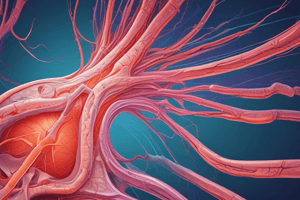Podcast
Questions and Answers
What is the primary function of connective tissue?
What is the primary function of connective tissue?
- Production of hormones
- Contraction of muscles
- Support and connection of body structures (correct)
- Regulation of body temperature
Where can connective tissue be found in the human body?
Where can connective tissue be found in the human body?
- In bone, cartilage, tendons, ligaments, and skin (correct)
- Primarily in the nervous system
- Exclusively in the blood vessels
- Only in the muscles
What is the role of osteocytes in connective tissue?
What is the role of osteocytes in connective tissue?
- Formation and maintenance of bone tissue (correct)
- Production of red and white blood cells
- Production of collagen and elastin
- Connection of muscles to bones
Which type of cell is responsible for the formation of cartilage?
Which type of cell is responsible for the formation of cartilage?
What is the role of the extracellular matrix in connective tissue?
What is the role of the extracellular matrix in connective tissue?
Which disorder is characterized by abnormally long and thin limbs, a curved spine, and a bent chest?
Which disorder is characterized by abnormally long and thin limbs, a curved spine, and a bent chest?
What is the main component of dense connective tissue that provides strong support to bones and other structures?
What is the main component of dense connective tissue that provides strong support to bones and other structures?
Which type of connective tissue is characterized by being less dense and having a higher water content, making it more flexible and able to stretch?
Which type of connective tissue is characterized by being less dense and having a higher water content, making it more flexible and able to stretch?
What is the main function of bone as a type of connective tissue?
What is the main function of bone as a type of connective tissue?
Which group of disorders affects the connective tissue, causing joint hypermobility, skin that bruises easily, and a range of other symptoms?
Which group of disorders affects the connective tissue, causing joint hypermobility, skin that bruises easily, and a range of other symptoms?
Flashcards are hidden until you start studying
Study Notes
Connective Tissue
Connective tissue is a type of tissue that provides support for the body and connects various structures of the body to one another. It is the most abundant tissue in the human body and can be found in various locations, including bone, cartilage, tendons, ligaments, skin, and blood vessels. Connective tissue is essential for maintaining the structural integrity of the body and plays a crucial role in various bodily functions.
Functions
The primary function of connective tissue is to support and connect various structures of the body. This includes providing structural support for bone and cartilage, connecting muscles to bones through tendons and ligaments, and protecting vital organs with the help of encapsulating membranes. Additionally, connective tissue helps in the movement of substances from one part of the body to another and plays a role in the production of red and white blood cells.
Cells
Connective tissue cells can be divided into three main types: fibroblasts, chondrocytes, and osteocytes. Fibroblasts are the most numerous cells in connective tissue and are responsible for the production of collagen, elastin, and glycosaminoglycans. Chondrocytes, on the other hand, are responsible for the formation of cartilage, which is a specialized form of connective tissue. Osteocytes are responsible for the formation and maintenance of bone tissue.
Disorders
Several disorders can affect connective tissue, leading to problems in various parts of the body. Some of these disorders include:
- Marfan syndrome: A genetic disorder that affects the connective tissue, resulting in abnormally long and thin limbs, a curved spine, and a bent chest.
- Ehlers-Danlos syndrome: A group of disorders that affect the connective tissue, causing joint hypermobility, skin that bruises easily, and a range of other symptoms.
- Osteogenesis imperfecta: A group of disorders that affect the formation and quality of bone tissue, leading to fragile bones and a range of other symptoms.
Extracellular Matrix
The extracellular matrix is the non-cellular part of connective tissue that surrounds and supports cells. It is composed of various types of proteins, including collagen, elastin, and glycosaminoglycans. The extracellular matrix plays a crucial role in maintaining the structural integrity of connective tissue and providing support to cells.
Types
Connective tissue can be classified into several types based on its structure and function. These types include:
- Dense connective tissue: This type of connective tissue is characterized by its high content of fibroblasts and collagen fibers, providing strong support to bones and other structures.
- Loose connective tissue: This type of connective tissue is less dense and has a higher water content, making it more flexible and able to stretch.
- Cartilage: This specialized form of connective tissue is composed of chondrocytes and has a higher water and proteoglycan content, providing support and cushioning to joints.
- Bone: While not technically a type of connective tissue, bone is closely related and serves a similar function in providing support and protection to the body.
In conclusion, connective tissue is a vital component of the human body, providing support and connecting various structures. Its cells, including fibroblasts, chondrocytes, and osteocytes, work together to maintain the structural integrity of the body and perform various functions. Disorders affecting connective tissue can lead to a range of symptoms, while the extracellular matrix supports and connects cells within the tissue. Understanding the structure and function of connective tissue is crucial for maintaining overall health and well-being.
Studying That Suits You
Use AI to generate personalized quizzes and flashcards to suit your learning preferences.




